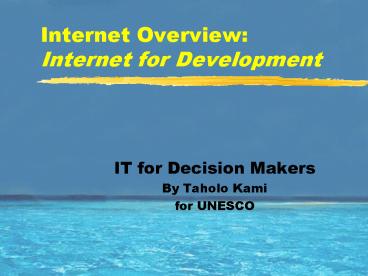Internet Overview: Internet for Development - PowerPoint PPT Presentation
1 / 18
Title:
Internet Overview: Internet for Development
Description:
Internet Overview: Internet for Development IT for Decision Makers By Taholo Kami for UNESCO Mission Improve the quality of life of the people of .(Name of ... – PowerPoint PPT presentation
Number of Views:518
Avg rating:3.0/5.0
Title: Internet Overview: Internet for Development
1
Internet OverviewInternet for Development
- IT for Decision Makers
- By Taholo Kami
- for UNESCO
2
Mission
- Improve the quality of life of the people of
.(Name of Country)
3
Objectives - Overall
- Overview and understanding of ICT opportunities,
issues and implications for (Insert Name of
Country) - Matching national / sectoral priorities and ICT
opportunities. - Identifying actions that will enable a knowledge
driven society.
4
Objectives - Participants
- All participants understand the possibilities
available to them in their various roles in the
information age. - All participants are able to identify
opportunities and issues that directly affect
them and initiate actions for change.
5
What is the Internet?
- Global Network
- Computers connecting people
- 400 million users
- Educated / up market but spreading quickly
- Implications in the Pacific
- Globalization
- Access to global information resources
- Extends marketing possibilities
- Instant communications
6
A Global Network
7
Global Online Population?
- 350 - 407 million - Dec 2001
- USA/ Canada 167 m
- Europe 113m
- Asia / Pacific 104.8
- 74.6m or 71 from Australia, NZ, Japan, South
Korea, Singapore, Taiwan, Malaysia. - Africa 3.1m
- Middle East 2.4m
- Latin America 16.45
- Source Nua Internet Surveys
8
Obstacles - Access and Participation
- Access -
- Expensive
- Cost of Computer
- Internet Connectivity - 1- 8/hour for dial up
connection - Internet Penetration
- Less then 3 of population
- Limited to capital or key cities
9
Obstacles - Capacity
- Awareness of Internet potential
- Unaware of Existence of Network / s
- Cost vs. Benefits unconvincing
- Untrained users
- Local IT skills are premium commodities
- Computer literacy still low
10
Internet Applications
- E Commerce
- Tele medicine / Health
- Distance Education
- E Governance
- Agriculture Knowledge Networks
- Virtual Communities
11
Strategy
- Infrastructure
- Human Capacity Building
- Investment
- Policy and Regulation
12
Components
- Infrastructure
- In Developed Countries the challenge is now
getting the under privileged and remote areas
online - Developing Countries basic Telecommunications
infrastructure competes with roads, electricity,
transport, education for funding. - Economic returns of Telecommunications
infrastructure is more difficult to quantify.
13
Policy and Regulation
- I.T. Policy should be aimed at creating an
enabling environment with affordable access at
its core. - Duty Free for IT Hardware
- Cost / Benefits determined
- Incentives for Investment in IT
- Sound Business Environment
14
Capacity Building
- Developing local capacity in IT skills via
education and incentives - Benchmarks
- Training Teachers - Priority
- All Students at 4th Form level.
- Build value into an Internet Passport scheme
- Pilot projects in core development priority areas
- Tourism, Trade, Governance
15
Financial Support
- Financial commitment from Government and donors
to strengthen key sectors for development
including Telecommunications infrastructure. - Identify core competency areas and fund
development of information tools in these
fields. - Synergy will lead to IT development in other
fields
16
E Culture
- A culture of innovation and entrepreneurship must
be developed - Recognize impact on society and develop strategy
to counter negative issues. - Develop strategies for building local content and
utilizing the Internet to enhance and promote
culture
17
Conclusion
- The Internet provides opportunities to new and
expanded markets for the Pacific Islands. - Information technology provides new development
opportunities to enhance and transform national
services such as governance, education, health
and commerce. - A concise national IT strategy will ensure scarce
resources are utilized in providing necessary
infrastructure and services to enable IT
development in key sectors.
18
Ground Rules
- 1. Its all about People
- Sell Value - benefits
- Connect to objectives
- 2. Relevance Not Reverence
- Keep technology in perspective
- Vehicle for achieving our objectives
- 3. Keep a Borderless perspective
- 4. Innovate. Break the Rules































